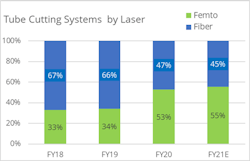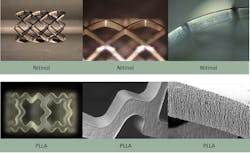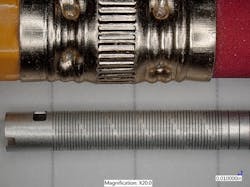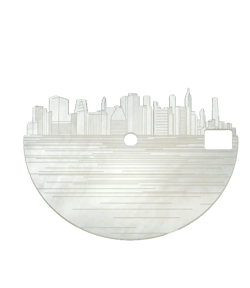Femtosecond laser processing is a flourishing production tool
Improved performance and cost advances in femtosecond lasers, together with a growing demand for superior cut quality in medical devices and other precision components, helped take the unique advantages of femtosecond laser processing from a promising method to a frontline production tool.
Femtosecond vs. fiber lasers
Femtosecond laser cutting is quickly emerging as a valuable tool in various production settings. This is evidenced by the sales data in Figure 1, which shows a huge jump between 2019 and 2020, compared to more ubiquitous fiber lasers. But why? What has changed?
Four main factors caused this recent shift toward femtosecond laser processing from longer pulsed (e.g., fiber) lasers: The superior edge quality with femtosecond laser processing; improved overall femtosecond costs have reached an economic tipping point; a growing demand for devices that can only be cut, or cut much better, by femtosecond lasers; and easier-to-use turnkey femtosecond systems with an intuitive, user-friendly graphical user interface (GUI).
The unique combination of advantages using femtosecond lasers for materials processing has long been known. In traditional materials processing using microsecond and nanosecond lasers, the primary laser-material interaction is photothermal, creating a heat-affected zone (HAZ). In precision applications, this limits the minimum size of features that can be cleanly machined without melting. It can also cause unacceptable functional or cosmetic damage in surrounding material, and often requires mechanical post-processing (e.g., deburring, manual polishing, or reaming).
In contrast, the femtosecond laser delivers orders-of-magnitude shorter pulses with much higher peak power that instantly vaporize material before heat conducts into the part. These pulse characteristics also enable any material processing plus processing of mixed material parts such as polymer/metal layers. Femtosecond laser pulses also do not produce recast debris, so grinding/polishing is not required after cutting.
Just as important, femtosecond lasers have reached a new level of maturity in terms of performance, economy, and reliability. One example is the Coherent Monaco series, in which the maximum power has been successively increased from less than 20 W to over 60 W during the time span shown in Figure 1.
The cost per watt for most femtosecond lasers has also recently dropped, so these lasers can deliver higher throughput together with lower cost per part. The Monaco has been operating in 24/7 demanding production environments for many years, underlining the increased reliability of femtosecond lasers that further contributes to the lower overall cost of ownership. Together with the cost savings from eliminating mechanical post-processing steps, this has resulted in an economic tipping point for several precision cutting tasks.
Many markets for laser processing are undergoing a push for miniaturization, either to increase functionality without increasing overall dimensions or to enable completely new applications. Medical devices (e.g., peripheral stents and minimally invasive tools) characterized by smaller, thinner-wall components with an increased number of cut details are inarguably the big driver causing the recent increased uptake in femtosecond laser processing. This is particularly the case in demand for machines configured for tube cutting geometries, but other industries are moving toward this technology as well. Indeed, there are now plenty of examples in electronics/displays including wafer dicing and OLED cutting. Even certain luxury goods such as Swiss watches are using femtosecond lasers, where both function and aesthetics are improved using parts with higher detail and precision.
Another key factor is the availability of turnkey industrial cutting and machining systems optimized for common tasks. Manufacturers of electronics, medical devices, and other precision components need complete solutions rather than standalone lasers. Flexible, easy-to-use software as well as machine agility and versatility are key in many medical device applications, where contract manufacturers typically produce small batches of many different custom devices. In this market, an order of several thousand identical parts is considered a large volume. As such, it’s vital a machine can be programmed easily and quickly to maximize overall throughput—all without requiring extensive training or special expertise. Fundamental to this is the knowledge and understanding of optimizing femtosecond lasers for applications and production processes.
Advancing medical devices
Medical devices are some of the main drivers for the recent uptake in femtosecond laser processing, but they also nicely encapsulate the market evolution of femtosecond lasers in general. In the past, the higher cost of femtosecond processing meant only devices not able to be cut by other means used this technology, and the initially low power meant only very thin parts could be processed with reasonable throughput rates. Higher power and more attractive costs today mean femtosecond processing is increasingly used for a wider range of devices previously cut with longer pulsed (e.g., fiber) lasers.
One advantage of femtosecond laser technology is its ability to machine just about any material (see Fig. 2). Early applications for these lasers were bioresorbable stents. Stents dissolved by the body over time address the issue of restenosis, where stents sometimes act as sites for reforming plaque and vessel blockage. The first examples were created from organics, such as polylactic acid (PLLA). Initially, green picosecond lasers were used, but the results were not optimum and femtosecond lasers were soon adopted as the de facto standard. Then, resorbable metal (magnesium) stents were developed. Fiber laser processing them created small metal droplets requiring ream cleaning—this often broke the delicate stents with yields as low as 50%. Again, femtosecond lasers became the standard method. Other early adopters were the thin platinum and iridium x-ray marker bands cut from thin (~40 µm) wall tubing of these high-value metals.Today, femtosecond laser machines are used for all kinds of medical device materials, including the increasingly popular nitinol (super-elastic metal) components such as stents and valve scaffolds. This shift is a direct consequence of lower overall costs, thanks to the reduction in labor-intensive deburring and electropolishing, and a corresponding increase in yields and reduction in waste nitinol. The femtosecond laser also avoids the need for wet cutting used with fiber lasers to control HAZ. The higher available power of the latest femtosecond laser enables thicker devices, including peripheral venous stents, which need to be thicker than arterial stents, as well as heart valve frames (500–700 µm wall thickness).
Medical contract manufacturing: Fiber, femtosecond, or both?
Femtosecond laser cutting is growing fast within the medical device market and perhaps the biggest question for anyone acquiring a new machine today is the choice between femtosecond or fiber laser. The main remaining advantage for the fiber laser is its ability to cut faster and to cut thicker parts, thanks to its higher available power. But, for thinner parts, power and speed advantages are often reduced because of the need to lower the repetition rate and avoid cumulative thermal damage. The bottom line is the optimum laser type really depends on the application specifics. And even in a single device, there may be cuts that can be made more economically with a fiber versus a femtosecond laser, and vice versa.
This is a reason why the latest laser machines for cutting medical devices are now available with a choice of femtosecond or fiber laser, or as a hybrid option with both lasers. An example of this machine type is the StarCut Tube series from Coherent. With it, the software allows the user to switch between laser types even during the cutting of a single device, delivering the most cost-effective production.
Systems in action
Motion Dynamics (Fruitport, MI), a manufacturer specializing in custom micro-springs, medical coils, and wire components for medical devices, puts a major emphasis on complex assemblies for neurovascular procedures, encompassing the design, production, and assembly of high-quality wire components for applications such as steerable catheter devices (“pull-wire” assemblies, among them).
For several years, the company has used laser cutting technology (see Fig. 3) as well as a machine equipped with a femtosecond laser (the Coherent StarCut Tube). Increased customer demand in more recent years prompted the purchase of a second machine—this one a hybrid model with both femtosecond and fiber lasers “for maximum versatility and utility,” according to Chris Witham, president of Motion Dynamics.He notes these machines perform equally well over a full range of metals, including stainless steel, pure gold, platinum, and nitinol.
Other important applications currently benefitting from femtosecond laser processing include wafer dicing and OLED cutting. An interesting application is creating small parts for high-end Swiss watches. Unlike medical devices that commonly start with tubular blanks, most of these watch parts are cut from flat substrates using machines optimized for this purpose.
TechnoCut (Bonfol, Switzerland) was a very early adopter of femtosecond laser technology. The company was founded in 2005 with the aim of using laser technology for contract manufacturing of small parts for the country’s iconic industry, primarily involving laser cutting and engraving (see Fig. 4). Company co-founder and technical director Julien Montavon says his team chose a femtosecond laser for its versatility. “The watch industry uses an incredibly wide range of materials,” he notes, including internal parts fabricated from brass, copper alloy, and steel. The watch’s face and hands can incorporate “all kinds of metals and ‘exotic’ non-metals to increase their aesthetic appeal and perceived brand value and exclusivity.” He cites ceramics, carbon fibers, mother of pearl, and various precious metals.All of these are readily cut with a femtosecond laser, often with no need for post-processing steps such as tumble polishing. Today, Montavon says TechnoCut operates four femtosecond laser cutting machines in their work.
Femtosecond laser processing now represents a fast-growing segment of the industrial laser marketplace. While the advantages of these unique lasers have long been known, it is recent advances in the overall cost, together with higher available power, tipping the laser choice in favor of femtosecond lasers in a number of important and diverse cutting and machining applications.
Roland Woelzlein | Product Line Manager, Coherent
Roland Woelzlein is a product line manager at Coherent Munich GmbH & Co. KG (Gilching, Germany).
Thomas Schreiner | Product Line Manager, Coherent
Thomas Schreiner is a product line manager at Coherent Munich GmbH & Co. KG (Gilching, Germany).



